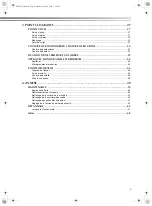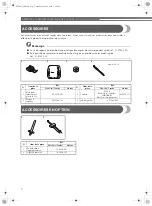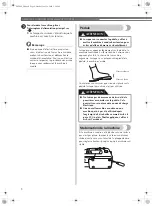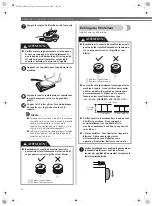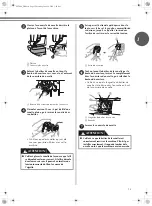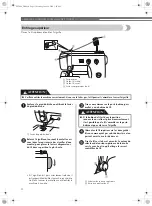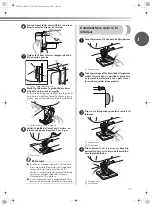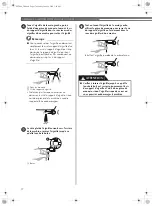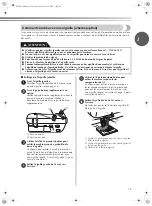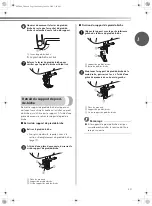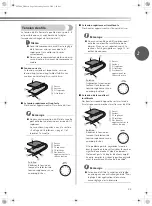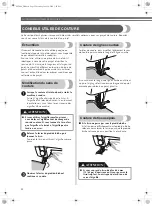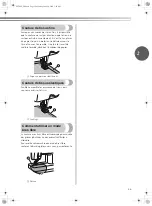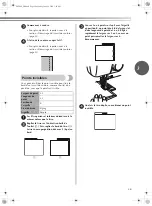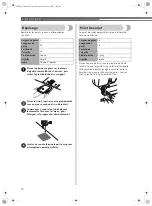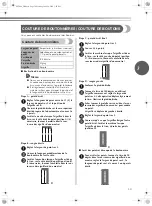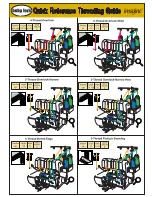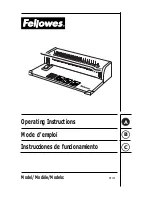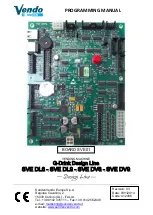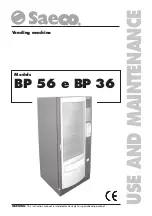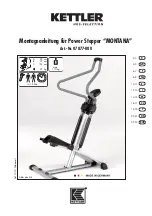
APPRENEZ À CONNAÎTRE VOTRE MACHINE À COUDRE
——————————————————————————————————————
15
REMPLACEMENT DE L’AIGUILLE
Cette section donne des informations sur les aiguilles de la machine à coudre.
Précautions relatives à l’aiguille
Veillez à respecter les précautions suivantes relatives à la manipulation de l’aiguille. Le non-respect de ces
précautions présente un grand danger. Lisez attentivement et respectez scrupuleusement les instructions ci-
dessous.
Sélection de l’aiguille en fonction des types de fil et de tissu
L’aiguille à utiliser dépend du tissu et de l’épaisseur du fil. Consultez le tableau suivant pour choisir le fil et
l’aiguille appropriés au tissu à coudre.
Utilisez la même taille de fil pour le fil supérieur (bobine) et le fil inférieur (canette).
Mémo
●
Plus le numéro du fil est petit, plus le fil est épais, et plus le numéro de l’aiguille est grand, plus
l’aiguille est grosse.
●
Lorsque vous cousez des tissus élastiques ou des tissus pour lesquels des points sautent fréquemment,
utilisez l’aiguille à pointe boule.
●
Utilisez une aiguille 90/14 à 100/16 avec les fils en nylon transparent, quel que soit le type de tissu.
●
Une aiguille 75/11 est installée lorsque vous achetez la machine à coudre.
●
N’utilisez que des aiguilles à coudre pour machine à usage domestique. N’utilisez pas d’autre aiguille :
elle risquerait de se tordre ou la machine pourrait être endommagée.
●
N’utilisez jamais d’aiguilles tordues. Elles peuvent facilement casser et vous blesser.
Tissus
Calibres d’aiguilles
Tailles des fils
Très fins
Tricot léger, fine
dentelle, lin délicat,
soie, organza,
mousseline
65/9
Coton : 80
Synthétiques/ Polyester
longues fibres
Coton mercerisé fin
Légers
Voile, taffetas,
synthétiques, soie,
batiste
75/11
Coton : 60-80
Soie : « A »
Synthétiques/ Polyester
longues fibres
Mercerisé 50
Moyens
Coton, guingan,
popeline, percale,
piqué, satin, velours,
laine légère,
velours côtelé fin, tissus
de confection,
lin, mousseline
90/14 (livrés avec la
machine)
Coton : 50-60
Soie : « A »
Synthétiques/ Polyester
longues fibres
Mercerisé 50-60
Lourds
Toile de jean,
gabardine, tweed,
velours côtelé,
canevas, coutil
100/16
Coton : 40-50
Mercerisé très résistant
Polyester longues fibres
Tricots
Tricot simple, double,
jersey, tricot en général
90/14 (pointe boule)
Polyester guipé coton
Polyester longues fibres
ATTENTION
LS2000_FR.book Page 15 Monday, June 28, 2010 3:20 PM




